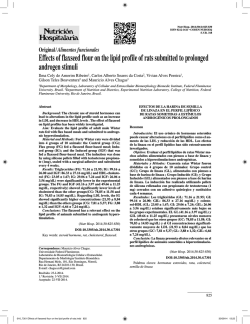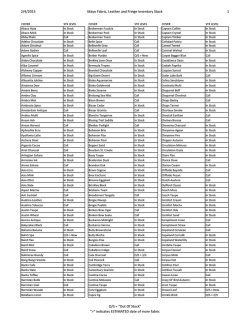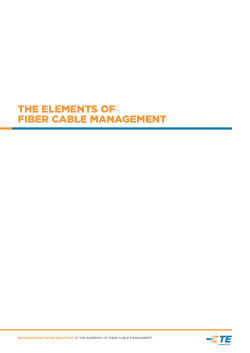
Experimental mutagenesis in fiber flax breeding
Kestutis Baèelis Experimental mutagenesis in fiber flax breeding Kestutis Baèelis Upytë Research Station of Lithuanian Institute of Agriculture LT-5335 Upytë, Panevëþys distr., Lithuania E-mail: lzi.upytë@post.omnitel.net The effects of different concentrations of nitrosoethyl urea, nitrosomethyl urea, ethyl methanesulphonate, ethylene imine, dimethyl sulphonate and various doses of gamma rays on variability of the flax varieties Svetoch and Vaiþgantas were tested. The frequency and spectrum of mutations as well as the number of useful mutant types were determined in generation M2. In later generations the mutant lines, distinguishing themselves by valuable qualities, were selected and some were involved into breeding process. Key words: fiber flax, mutagenesis, mutagen concentration, dose, mutant type INTRODUCTION Besides application of intervarietal crossing and selection in fiber flax and linseed breeding, methods of physical and chemical mutagenesis [14] are applied to create the source material. The application of these methods yielded many valuable flax mutants [5, 9] and varieties [1012]. The following chemical mutagen are widely used in experimental mutagenesis: NEU (nitrosoethyl urea), NMU (nitrosomethyl urea), EMS (ethyl methanesulphonate), EI (ethylene imine), DMS (dimethyl sulphonate) [1, 6, 7, 13] and also physical mutagens X-rays and gamma rays [1315]. It has been established that, by treating linseeds with ionizing radiation or chemical agents, it is possible to obtain new plant forms characterized by a diversity of morphological characters or physiological properties [3, 5, 10, 16]. The aim of our investigations was to research the reaction of the fiber flax varieties Svetoch and Vaiþgantas to the effect of various rates of gamma rays and concentrations of chemical mutagens, to investigate the mutability of these varieties, the frequency of inductive mutations and their dependence on a mutagen, its concentration or dose, the spectrum of mutations, as well as to determine the number of mutant types useful for fiber flax breeding, to select the flax mutant lines distinguishing themselves with valuable properties and characters. MATERIALS AND METHODS Seeds of the flax varieties Svetoch and Vaiþgantas were irradiated with gamma rays (the source ISSN 13920146. B i o l o g i j a . 2001. Nr. 1 " was 60Co) in the Laboratory of Radiation biophysics at the Institute of Agrophysics (St. Petersburg) at the following 14 doses: 1; 5; 11,5; 20; 30; 40; 50; 60; 70; 80; 90; 100; 125 and 150 KR (KR kiloroentgen, 1 KR = 1000 roentgens), and the gamma rays 750 R/min. One thousand seeds were treated in each treatment. In the other trial seeds were soaked in water solutions of NEU 0.012; 0.025 and 0.05% for 18 h; of NMU 0.006; 0.012 and 0.025% for 18 h, 1000 seeds were treated in each treatment; of EMS 0.1; 0.2; 0.3 and 0.4%; of EI 0.01; 0.02; 0.03; 0.04 and 0.05% for 12 h and for 18 hrs soaked in water solution of DMS 0.016; 0.025 and 0.05% (500 seeds). The seeds were treated with mutagen in accordance with the methodic instructions issued by the Institute of Chemical Physics at the Russian AS [17]. The soaked seeds were washed with water, then slightly dried and sown in the trial field within 23 days, while seeds treated with ionizating radiation were sown within 6 days. They were sown in a 1 m belt with 10 cm interrow distance and 150 seeds per row. Seed germination, plant growth and development, various morphological and physiological deviations were observed in M1 generations (1971). M2 generations (1972) were sown out in separate lines, in which the character of changes caused by various treatments, their frequency and the spectrum of chlorophyllic, morphological and physiological mutations were observed. The number and frequency of induced mutations, depending on the treatment were established by the following methods: a) percentage of lines with changed plants (relative to the total number of lines); b) percentage of changed plants (relative to the total number of plants) [17]. Experimental mutagenesis in fiber flax breeding The mode of inheritance of changes was established in M3 and M4 generations. After propagation of seeds, valuable lines were sown in the breeding nursery (19731986 and 19872000), in which economicbiological properties and characters of mutants and various parameters of productivity were established. All field trials, phenological observations and laboratory tests were conducted according to methodical instruction [18]. The meteorological conditions during the years of the test (19732000) were not similar. The years 1973, 1975, 1979, 1982, 1990, 1991, 1993, 1996 and 1997 were favorable for flax growing. The seed and stem yield was perfect in those years. Not favorable weather conditions were in 1976, 1980, 1983, 1985 and 1998 the flax was lodged by the rains. In 1992 and 1994 dry summer reduced flax yield. The yield was not great in all of the years. RESULTS AND DISCUSSION When treating with low (1; 5; and 11.5 KR) and high (125150 KR) doses, no chlorophyllic mutations were noticed in M2 generation. With increasing the irradiation dose (from 20 KR), the number of chlorophyllic mutations in both varieties changed differently. Most of them occurred in Vaiþgantas (treated with 50 KR (2.39%) and in Svetoch at 70 KR (1.42%). The distribution of chlorophyllic mutations in both varieties in the M2 generation was as follows: viridis 33.3% to 55.8%, xantha 10.0 to 55.6%, striata 5.6 to 28.5% and maculata 2.6 to 16.7%. Morphological and physiological mutations were most frequent (0.97 to 2.44%) in the flax variety Svetoch, when the seed was treated with 50 to 150 KR doses, while in Vaiþgantas (1.30 to 2.76%) they were found when the seed was treated with 80 to 125 KR. The following mutant types were revealed: large-seeded, small-seeded, early, late, long, with increased fibre output, lodging resistant, disease resistant, productive, etc. Also the number of mutant types was revealed depending on gamma rays (Table). The same chlorophyllic, morphological and physiological flax mutations were noted in the trials with chemical mutagen in M2 generation. The data show the number of changed plants to be directly proportional to the concentrations of NEU, NMU, EMS, EI and DMS of mutagens. Among chemical mutagens, the larger of mutant types were induced by NEU, NMU and EMS, and the smaller by EI and DMS. Various selected mutant M2 plants had a different degree of stability in M3 and M4 generations. Flax inherited morphological and physiological changes in the later generations as follows: increased fiber output 6788%, increased earliness 70100%, increased lateness 89100%, increased lodging resistance 6080%, seed size 6080%, etc. Many valuable mutant lines were selected and tested in various breeding nurseries and provocative (infections of flax diseases) backgrounds [18] over 19761986 and 19871998. From the research data rather valuable lines were obtained. Some of them are described below: S-5-197 (20 KR) produces a linseed yield by 25% higher than the initial variety Svetoch. The fiber output is by 3.54.4% higher, the growth period is by 3 days longer. S-2-22 (90 KR) gives linseed yield than by 15% higher Svetoch. Fiber output is by 3.04.5% higher, fiber quality is good. Flax plants grow by 15 cm longer and their growth period is by 5 days longer. They are less damaged by seedling blight (antrachnose Colletotrichum lini M. et B.). Table. The number of changed plants and mutant types in flax M2 generation when applying gamma rays or chemical mutagen Mutagenic treatment The number of mutant types Changed plants total valuable for breeding Dose KR, concentration % Svetoch Vaiþgantas Svetoch Vaiþgantas Svetoch Vaiþgantas 1 2 3 4 5 6 7 1 3 5 4 6 6 11 0 0 0 1 2 2 2 0 1 1 2 3 3 4 Check 1 5 11.5 20 30 40 0.41 0.46 0.48 0.53 0.65 0.51 0.73 ± ± ± ± ± ± ± 0.41 0.21 0.12 0.15 0.16 0.14 0.21 0.52 0.16 0.41 0.39 0.60 0.53 0.67 ± ± ± ± ± ± ± 0.52 0.11 0.24 0.19 0.24 0.14 0.13 Gamma rays 1 2 5 7 6 9 10 " Kestutis Baèelis 1 2 3 50 60 70 80 90 100 125 150 0.97 1.36 1.22 1.52 1.45 1.02 0.83 2.44 ± ± ± ± ± ± ± ± 0.21 0.23 0.22 0.34 0.23 0.22 0.59 2.41 0.88 0.69 0.80 1.33 1.51 1.30 2.76 0.45 ± ± ± ± ± ± ± ± Check NEU 0.012 NEU 0.025 NEU 0.05 Check NMU 0.006 NMU 0.012 NMU 0.025 Check EMS 0.1 EMS 0.2 EMS 0.3 EMS 0.4 Check EI 0.01 EI 0.02 EI 0.03 EI 0.04 EI 0.05 Check DMS 0.016 DMS 0.025 DMS 0.05 0.07 1.70 3.30 5.90 0.07 1.80 4.50 4.60 0.03 1.40 2.10 3.40 4.40 0.70 2.30 2.80 3.70 3.50 4.10 0.20 1.70 1.90 1.80 ± ± ± ± ± ± ± ± ± ± ± ± ± ± ± ± ± ± ± ± ± ± ± 0.04 0.10 0.20 0.30 0.04 0.10 0.20 0.60 0.03 0.30 0.40 0.50 0.70 0.30 0.30 0.30 0.30 0.40 0.50 0.10 0.40 0.30 0.30 0.05 1.60 2.30 3.50 0.05 2.40 3.80 5.60 0.02 1.40 3.20 4.50 3.60 0.30 2.10 2.00 2.60 2.90 2.60 0.20 0.90 1.80 2.00 ± ± ± ± ± ± ± ± ± ± ± ± ± ± ± ± ± ± ± ± ± ± ± 4 0.26 0.17 0.21 0.34 0.37 0.26 0.61 0.45 Chemical 0.03 0.10 0.10 0.30 0.03 0.20 0.20 0.60 0.02 0.20 0.40 0.60 0.70 0.20 0.30 0.30 0.30 0.30 0.30 0.20 0.30 0.30 0.40 V-26-228 (30 KR) produced a stem and linseed yield by 9% higher. Fiber output is by 2.83.7% higher, fiber quality is good. Growth period is shorter by 3 days, the plants are less damaged by fusariose (Fusarium spp.). E-3-310-5 (NEU 0.025%) gives by 78% higher stem and linseed yield than does Vaiþgantas. Fiber output is by 3.1% higher, its quality is good. The flax is by 0.7 points more lodging-resistant, the stems are less damaged by fusariose (Fusarium spp.) and rust (Melampsora lini Desm.). F-5-398-4 (NMU 0.006%) is white-blossomed, grows by 20% of stems and 14% of linseed more than the initial variety Vaiþgantas. Fiber output is by 2.3% higher. The flax plants grow up long, are lodging-resistant and less affected by fungal diseases. G-2-109-5 (EMS 0.4%) gives stem and linseed yield by 2225% higher than does the initial variety Svetoch. Fiber output is by 2% higher, its quality is good soft, flexible, strong. The plants grow by " 12 12 13 12 14 10 3 1 mutagen 1 22 27 28 0 22 26 25 1 16 17 21 20 0 11 13 17 18 14 0 12 14 13 5 6 7 9 11 11 10 8 9 7 2 3 4 4 4 3 2 0 0 4 4 4 4 3 1 1 0 1 22 25 27 0 29 25 25 1 14 17 22 20 0 15 16 16 19 17 0 15 13 12 0 7 9 6 0 9 9 5 0 4 7 6 4 0 2 2 3 2 1 0 3 2 1 0 6 7 5 0 5 4 3 0 4 4 5 3 0 1 1 4 3 2 0 2 2 1 10 cm longer, by 0.8 points are more lodging-resistant. The mutant is white-blossomed. The mutant lines C-3-313-4 (NEU 0.025%), E-2-17-3, E-2-17-7 (NEU 0.012%), F-5-168-4 (NMU 0.006%), M-5-5-4 (EMS 0.4%) and other were charaterized by abundant stem, linseed and fiber yield. Different weather conditions over research years gave an opportunity to select lodging-resistant flax mutant lines such as E-2-17-3, E-2-17-6, E-2-17-7, E-2-147-4 (NEU 0.012%), F-5-345-1, F-5-398-3 (NMU 0.006%), 4V-3 (EI 0.03%), 2V-6 (EI 0.01%), F-6-66-1 (NMU 0.012%), M-2-18-2 (EMS 0.1%), M-3-114-4 (EMS 0.2%), G-4-44-1 (EMS 0.3%), etc. The following mutant lines have high fiber output: A-3-56-7 (NEU 0.025%), E-4-4-430-2 (NEU 0.05%), M-4-44-4 (EMS 0.4%), E-2-17-5, E-2-622 (NEU 0.012%), etc. A-3-126-1, E-3-343-2 (NEU 0.025%), F-5-4061, F-5-406-5 (NMU 0.006%), G-3-74-4 (EMS Experimental mutagenesis in fiber flax breeding 0.2%) and other lines have a short growth period. E-2-147-4 (NEU 0.012%), F-7-397-2 (NMU 0.025%), M4-107-7 (EMS 0.3%) and other mutant lines have a long growth period. The longest stems amongst the tested mutants belonged to the lines A-2-41-1, A-2-56-4 (NEU 0.012%), A-3-2-5 (NEU 0.025%), F-6-66-4 (NMU 0.006%), G-5-145-2 (EMS 0.3%) and other. Large linseeds characteristic to the lines: A-2-386, E-2-17-7, E-2-17-6 (NEU 0.012%), A-3-2-5, A3-56-7, E-3-224-2 (NEU 0.025%), F-7-30-1 (NMU 0.025%), M-5-44-4 (EMS 0.4%). Resistance to fusaria (Fusarium spp.) of fiber flax mutants C-2-115-3 (NEU 0.012%), F-5-113-3 (NMU 0.006%), M2-107-4, M-2107-7 (EMS 0.1%), etc. Resistance to rust (Melampsora lini Desm.) of fiber flax mutants: C-4-121-1 (NEU 0.05%), E-3-562 (NEU 0.025%), F-5-230-1 (NMU 0.006%), M-4-129-1 (EMS 0.3%), M-5-74-5(EMS 0.4%), etc. CONCLUSIONS 1. The spectrum and frequency of mutations in M2 generation of the flax varieties Svetoch and Vaiþgantas treated with various doses of physical or chemical mutagenes slightly different. 2. To obtain a more useful flax mutation, it is necessary to treat seeds with 2090 KR doses of gamma rays. When treating with a chemical mutagen, it is necessary to use only weak or medium concentrations: NEU 0.012 and 0.025%, NMU 0.006 and 0.012%, EMS 0.1; 0.2 and 0.3%, EI 0.01; 0.02 and 0.03% and DMS 0.016 and 0.025%. 3. The frequency of induced mutations, their spectrum and development of valuable forms revealed the efficiency of the test mutagens (in reducing sequence): NEU ~ NMU > EMS > gamma rays > EI ~ DMS. 4. When utilising chemical and physical mutagens in fiber flax breeding, new flax mutant lines valuable for cultivation were selected and introduced into breeding programs. References 1. Tejklova E. Breeding for fiber and oil quality in flax. St Valery en Caux, France. 1995; 4250. 2. Douglas GC. Nuclear techniques and in vitro culture for plant improvement. Proceedings of Symposium IAEA, Vienna 1986: 1218. 3. Kawai T, Amano E. Plant Mutation Breeding Crop Improv Vienna 1999; 1: 4766. 4. Nichterlin K, Marquard R, Friedt W. Plant Breeding 1988; 101: 1909. 5. Green AG. Can Jl Plant Sci 1986; 66 (3): 499503. 6. Pavelek M, Tejklova E. Producing for the market. Rouen, France 1996: 20312. 7. Íîâèêîâà ÀÔ. Õèìè÷åñêèé ìóòàãåíåç â ñîçäàíèè ñîðòîâ ñ íîâûìè ñâîéñòâàìè. Ìîñêâà 1986: 1624. 8. Ñÿ÷êîâà ÍÑ. Ñáîðíèê íàó÷íûõ òðóäîâ ÂÍÈÈ ëüíà. Òîðæîê, 1988; 25: 426. 9. Óùàïîâñêèé ÈÂ, Äîóðëåéí É, ßêîáñåí Ý. Èòîãè è ïåðñïåêòèâû ðàçâèòèÿ ñåëåêöèè, ñåìåíîâîäñòâà, âîçäåëûâàíèÿ è ïåðâè÷íîé îáðàáîòêè ëüíàäîëãóíöà. Òîðæîê 2000: 568. 10. Dribnenki JCP, Green AG. Can J Plant Sci 1996; 76 (2): 32931. 11. Äûííèê ÂÏ. Íîâûå ñîðòà, ñîçäàííûå ìåòîäîì õèìè÷åñêîãî ìóòàãåíåçà, Ìîñêâà 1988: 736. 12. Èâàøêî ËÂ. Ðîëü àäàïòèâíîé èíòåíñèôèêàöèè çåìëåäåëèÿ â ïîâûøåíèè ýôôåêòèâíîñòè àãðàðíîãî ïðîèçâîäñòâà. Æîäèíî 1998; 2: 2502. 13. Èâàøêî ËÂ. Õèìè÷åñêèé ìóòàãåíåç â ñåëåêöèîííîì ïðîöåññå. Ìîñêâà 1987: 15860. 14. Êðåïêîâ ÀÏ. Ëåí è êîíîïëÿ 1992; 1Æ 267. 15. Ralph W. Rural Res 1986; 130: 113. 16. Rowland GG. Can Jl Plant Sci 1991; 71: 3936. 17. Çîç ÍÍ. Ìóòàöèîííàÿ ñåëåêöèÿ. Ìîñêâà 1968; 21730. 18. Ìåòîäè÷åñêèå óêàçàíèÿ ïî ñåëåêöèè ëüíà-äîëãóíöà. Òîðæîê 1987. K. Baèelis PLUOÐTINIØ LINØ EKSPERIMENTINË MUTAGENEZË Santrauka Tirtas cheminiø mutagenø nitrozoetilðlapalo, nitrozometilðlapalo, etilmetansulfonato, etilenimino ir dimetilsulfato ávairiø koncentracijø ir fizinio mutageno gama spinduliø ávairiø doziø átaka veisliø Svetoè ir Vaiþgantas linø kintamumui. Nustatytas linø selekcijai naudingø mutantiniø tipø skaièius. M3 ir M4 kartose nustatytas ávairiø pakitimø paveldimumo laipsnis. Atrinkti linø mutantai, pasiþymintys ûkiðkai vertingomis savybëmis. Pateikiama kai kuriø jø charakteristika. "!
© Copyright 2024







